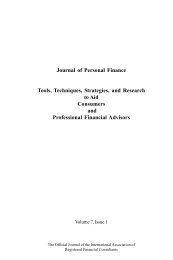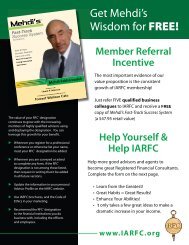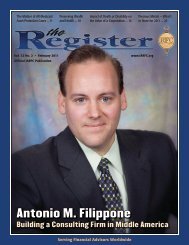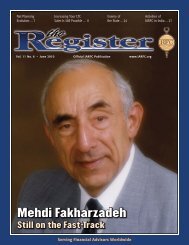3433-vol. 6 issue 2-3.pmd - iarfc
3433-vol. 6 issue 2-3.pmd - iarfc
3433-vol. 6 issue 2-3.pmd - iarfc
You also want an ePaper? Increase the reach of your titles
YUMPU automatically turns print PDFs into web optimized ePapers that Google loves.
20<br />
Journal of Personal Finance<br />
• Incorporating Financial Life Planning material into the practice gives<br />
the advisor literally a lifetime of in-depth topics for client meetings. A<br />
quality Financial Life Planning process provides dozens of formats<br />
and hundreds and hundreds of available, effective questions that<br />
can be used year after year to track the client’s current state of<br />
satisfaction and progress.<br />
• The process gives the advisor a great opportunity to ask for<br />
introductions to other prospects by asking, “Who else would benefit<br />
from this process?”<br />
A consistent, structured Financial Life Planning process also<br />
provides the advisor with a more operationally efficient environment and<br />
increases the value added benefit to the client. Think about the benefits of a<br />
process that offers clients the opportunity to fulfill their dreams and to have<br />
increased peace of mind. Think about the benefits of an approach that<br />
increases communication to get both spouses “on the same page.”<br />
In Conclusion<br />
Andrew Sobel (n.d.), an industry expert on building client relationships,<br />
retention and loyalty, states that “client loyalty boils down to three<br />
basic factors:<br />
• All clients in this market are loyal to people who continue to add<br />
tangible value<br />
• Clients are loyal to the people with whom they have built trust<br />
• Clients are loyal to advisors who go the extra mile for them, who<br />
really care about them as clients. These ideas may sound simple, but<br />
each has subtlety and complexity.”<br />
The <strong>issue</strong> in financial services, as in other professions, is that this<br />
commitment to clients must be consistently demonstrated with every prospect<br />
and client. In terms of adding value, financial professionals have to go<br />
beyond basic client expectations and they have to do it consistently.<br />
Clients have needs they are not yet aware of. These “latent needs”<br />
are real, but not yet in most clients’ awareness. If a provider understands such<br />
a need and fulfills it, the client is rapidly and uniquely delighted. Consider<br />
this example offered by Bob Veres (2006/2007):<br />
“One surprising theme of the messages I received was<br />
how much work advisors were having to put into helping<br />
their clients make the transition from accumulating to<br />
consuming their portfolios. Much of the work in<strong>vol</strong>ved<br />
helping clients translate a lump sum into an income<br />
©2008, IARFC All rights of reproduction in any form reserved.
















